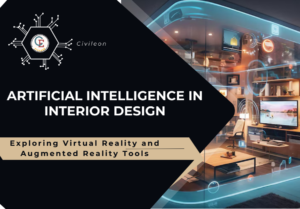Interior design is all about making the spaces where we live, work, and spend time look nice and feel comfortable. Designers think about things like what colors to use, what furniture to put in, and how to arrange everything so it’s easy to use. They want to create rooms that are both beautiful and practical. But now, with new technology like Artificial Intelligence (AI), Virtual Reality (VR), and Augmented Reality (AR), designing spaces has become even more fun and easier for everyone.
These tools help people imagine what a room will look like before it’s even built and can suggest the best furniture or color combinations based on what you like. This means that anyone can create their dream space, even if they’re not a professional designer. In this blog, “Artificial Intelligence in Interior Design: Exploring Virtual Reality and Augmented Reality Tools”, we’ll explore how AI, VR, and AR are transforming interior design, making it fun and easy to design your dream space.
What is Artificial Intelligence (AI)?
Artificial Intelligence, or AI for short, is a type of technology that allows computers and machines to think and learn like humans. Imagine a robot that can make decisions, solve problems, or even help you with tasks. That’s what AI can do, but instead of being a physical robot, it’s usually software or a computer program.
AI works by using something called algorithms. These are like sets of instructions that tell the computer what to do. AI programs can “learn” from a lot of data. Data could be anything from pictures, words, numbers, or patterns. When AI looks at this data, it finds patterns or important information that can help it make smart decisions. It is like how we learn by observing and practicing.
What are Virtual Reality (VR) and Augmented Reality (AR)?
Before we dive into how these tools are used in interior design, let’s break down what VR and AR are:
Virtual Reality (VR): VR is a computer-generated world that you can explore. You wear special goggles, and it feels like you are inside a video game or another place. In interior design, VR lets you walk around a room that hasn’t been built yet!
Augmented Reality (AR): AR adds digital objects to the real world. For example, you could point your phone’s camera at your living room, and an AR app would show you what a new sofa would look like in the actual space.
How AI is Used in Interior Design
In the world of interior design, artificial intelligence (AI) is becoming a game-changer. Just like how AI helps us in everyday tasks like choosing a movie or navigating roads, it’s now helping interior designers create beautiful and functional spaces. Interior design involves a lot of creativity and planning. Designers need to think about colors, furniture, spacing, and how everything comes together. This can be a lot of work, especially when trying to match a client’s vision and needs. This is where AI steps in. AI in interior design can do things like suggesting color schemes, predicting furniture that fits the space and style, and even creating entire room layouts based on trends and personal preferences.
-
Personalized Design Suggestions
AI can look at what you like and suggest designs that match your taste. If you love the color blue and modern furniture, AI can recommend items and ideas that fit those preferences. This makes the design process faster and more personal.
-
Optimizing Space
AI can help designers figure out the best way to use a room’s space. For example, if you have a small bedroom, AI can suggest furniture and layouts that make the most of the space without feeling cramped.
-
Saving Time
AI-powered tools can quickly analyze many different design options. Instead of designers spending hours coming up with ideas, AI can do it in minutes, giving them more time to focus on other important details.
-
Predicting Trends
Because AI can look at a lot of data, it can also predict future design trends. This helps designers stay ahead of the curve and create designs that are fresh and stylish.
Virtual Reality in Interior Design
Virtual Reality (VR) is changing the way people design and experience spaces. Imagine being able to step into a room that hasn’t even been built yet or see what your home will look like after a big makeover—all without leaving your couch. In interior design, VR allows designers and homeowners to explore rooms in 3D, try out different furniture, colors, and layouts, and get a real sense of what the finished space will look like before making any changes. This makes designing a room easier, faster, and more fun because you can see exactly what you’re going to get.
Instead of looking at flat pictures or drawings, VR puts you inside the room. You can walk around, check out the details, and decide if you like it or not. It’s like test-driving your new living room or kitchen before you make any big decisions. Virtual reality is making interior design more interactive and helping people create spaces they love with confidence.
-
Design Visualization
With VR, you can step into a virtual version of your room and see how it looks with different furniture, colors, and decorations. This helps you know exactly what to expect when the project is finished. You can even “walk” around the space and feel like you’re there.
-
Experimenting with Different Styles
Want to see how your room looks in different styles? With VR, it’s easy. Designers can quickly swap out furniture, paint colors, and decorations, letting you compare different looks in seconds.
-
Virtual Showrooms
Some furniture stores are using VR to create virtual showrooms. This means you can “visit” the store from home and see what their products look like in your space without having to leave the house.
-
Collaborating with Designers
If you’re working with an interior designer, VR can help you both be on the same page. You can put on a VR headset, and your designer can walk you through the space, explaining how everything will look and feel. This makes it easier to communicate your ideas and make changes.
Augmented Reality in Interior Design
Augmented Reality (AR) is changing the way we think about interior design by making it more interactive and easier to visualize. AR blends the real world with computer-generated objects, allowing you to see things that aren’t physically there like furniture, paint colors, or decorations in your actual space. This technology uses your phone, tablet, or special glasses to overlay digital images onto the real world, helping you design and decorate your home in a more engaging way.
In interior design, AR makes it possible to try out different ideas without moving a single piece of furniture or spending money on paint. You can use an app to point your device’s camera at a room, and the AR tool will show you how new furniture or décor items will look right in your home. This makes it easier to experiment with different styles, colors, and layouts.
For both designers and homeowners, AR takes away a lot of the guesswork. You don’t have to imagine how a piece of furniture will fit in your room or whether a certain color will look good on your walls. With AR, you can see it all instantly, helping you make smarter and quicker decisions when decorating or designing your space.
-
AR Apps for Home Design
Many apps now use AR to help people design their homes. You can point your phone or tablet at a room, and the app will let you try out different furniture, colors, or layouts. This makes it easy to see if that new sofa or coffee table will fit in your living room.
-
Making Smart Purchases
Buying new furniture can be a big decision. With AR, you can see how that piece of furniture will look in your home before you buy it. This helps you make smarter decisions and avoid buying something that doesn’t fit or match your space.
-
Customizing Your Space
AR allows you to customize the space on the go. For instance, you can play around with the positioning of furniture or add virtual décor items to see what works best before making any actual changes.
The Benefits of Using AI, VR, and AR in Interior Design
These new technologies bring lots of exciting benefits to the world of interior design. Here are just a few:
-
Better Visualization
One of the hardest parts of designing a room is trying to imagine what it will look like when it’s done. VR and AR solve this problem by letting you see your design ideas come to life in real time. No more guessing.
-
More Creativity
AI helps designers push the limits of creativity by suggesting new ideas and combinations that might not have been thought of before. This makes designs more unique and exciting.
-
Faster Decision-Making
With AI, VR, and AR, it’s easier to make decisions because you can see everything in advance. This means fewer mistakes and faster results. You can try out different ideas quickly and know which one will work best for you.
-
Cost-Effective
Sometimes, making changes to a design in the real world can be expensive. If you don’t like the paint color or the way the furniture is arranged, it can be costly to fix. With these tools, you can try everything out virtually first, saving you time and money.
The Future of Interior Design with AI, VR, and AR
As technology evolves, interior design will become even more exciting. AI (Artificial Intelligence) will be able to make designs that are just right for each person’s taste. It will know what colors, furniture, and styles you love and help create a room that feels perfect for you.
VR (Virtual Reality) and AR (Augmented Reality) will also improve and become easier for everyone to use. With these tools, you’ll be able to see your room in a super realistic way before it’s even built. You can walk around the room using VR or see how furniture looks in your real room using AR.
In the future, there could be even more advanced tools where you can design every little part of a room—from the biggest piece of furniture to the smallest decoration with the help of AI and VR. There will be so many possibilities, making it fun and simple to create the perfect space.
Conclusion
Artificial intelligence, virtual reality, and augmented reality are making interior design more exciting and accessible for everyone. AI helps by giving you personalized design ideas. VR lets you step into your future room before it’s even built, and AR helps you visualize furniture and decorations in your actual space. With these tools, creating beautiful spaces that fit your style has never been easier or more fun.
Feel free to follow us there on Instagram and drop a comment to say hello!



